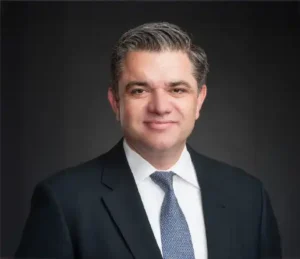FREMONT, Calif. – Aug. 25, 2025 – Washington Health is one of six hospitals in the country –the only hospital in Northern California – to offer robotic-assisted shoulder joint replacement, using the same technology that has transformed hip and knee joint replacement. The first procedure was performed today by John Costouros, MD, an orthopedic surgeon at the Institute for Joint Restoration and Research at Washington Health.
Dr. Costouros, a renowned shoulder surgeon and pioneer in shoulder joint replacement, joins a handful of U.S. surgeons skilled in the Mako SmartRobotics™ device, a robot that guides precision and preparation of the shoulder joint for a more customized fit during reverse total shoulder replacement. Using 3D CT scan, along with robotic and haptic (touch feedback) technology, the Mako SmartRobotics™ device enhances the surgeon’s skill to make the joint fit within 1 millimeter of accuracy and precision, better than the human eye. This is the same technology that has perfected hip and knee replacement for more than 1 million people in the United States for the past 18 years, according to Dr. Costouros.
Dr. Costouros trained at Stanford University, the University of California at San Francisco, and Harvard Medical School at Massachusetts General Hospital. He completed additional training in shoulder replacement technology in Zurich, Switzerland and throughout Europe where reverse total shoulder replacement technology was first developed prior to FDA approval in the United States in 2004. He was one of the first to bring this technology to the United States.
“Shoulder replacement is the fastest growing area of joint replacement surgery,” said Dr. Costouros, who is certified by the American Board of Orthopedic Surgery and has additional certification in Sports Medicine. “What we learned from hip and knee replacements we’re now adapting to the shoulder, which is inherently a much more complicated joint.”
Assisting in reverse shoulder joint replacement, the robotic device aids surgeons by guiding their hand in the operating room based on the surgical plan developed by the surgeon prior to surgery. The new technology’s software works with a 3D CT scan of the patient’s shoulder to help the surgeon map out how and where to prepare the bony surfaces to make the synthetic joint fit precisely to each person’s unique anatomy.
“The shoulder is the most complicated joint in the body, with a very complex anatomy and a dynamic interplay between bones and soft tissues enabling the widest range of motion of any joint,” said Dr. Costouros. “The complexity of the shoulder joint makes it ideal for use of this new technology.”
In a reverse shoulder replacement, Dr. Costouros replaces the ball on the socket side of the joint, the reverse of where it is naturally located. The socket is then placed on the other side, where it’s supported by a metal stem in the arm bone (the humerus).
“Before robots, we used precision tools, guides, augmented reality goggles, and other high-tech devices to execute the surgical plan,” said Dr. Costouros, noting that the most important skill is always the surgeon’s experienced hand. “But now we have robots and haptic assistance to guide us even further.”
While Dr. Costouros still performs traditional shoulder replacement, he explained that the robotic reverse shoulder procedure can treat a broader range of problems, including rotator cuff tear arthropathy, non-repairable rotator cuff tears, complex fractures, and prior failed joint replacements.
The new robotic technology improves outcomes, surgical accuracy, longevity of the implant, and patient satisfaction; while also preserving bone and reducing pain. “I expect that the same improvements that we have seen with hip and knee replacement surgery will be found for shoulder surgery. Patients will regain their quality of life,” Dr. Costouros added.
Dr. Costouros, who has trained surgeons around the world for more than two decades, will begin performing this robotic-assisted procedure at Washington Hospital later this month. “We’re moving forward in an age of precision medicine and transformational technology. It will only continue to improve outcomes and increase longevity of the artificial joint as the number of patients undergoing reverse total shoulder replacement continues to grow.”
“At Washington Health, we are proud to bring this new technology to our hospital to enhance the care we provide to our community. Yet technology alone is not enough. It is our exceptional physicians and clinical staff, with their expertise and compassion, who make it possible to turn innovation into the very best care for every patient,” said Chief Executive Officer, Kimberly Hartz.
Dr. Costouros added, “I’m privileged to work at one of the best sites around the world to offer this surgery, and to contribute to developing this technology further. This means we can continue to relieve pain and suffering in so many patients and improve the patient experience even more into the future,”
For more information about Washington Health’s joint replacement program and Dr. Costouros, visit www.californiashoulder.com and www.washingtonhealth.com/IJRR.
About Washington Health
Washington Health is an independent, community-based health system governed by the publicly elected Washington Township Health Care District Board. Opened in 1958, Washington Health has grown to include a 415-bed acute care hospital; the Bell Neuroscience Institute of Silicon Valley; the Institute for Joint Restoration and Research; Washington Outpatient Surgery Center; Washington Outpatient Rehabilitation Center; Washington Health Medical Group; and Washington West which houses the UCSF – Washington Cancer Center, Washington Women’s Center, Outpatient Imaging Center, and additional outpatient hospital services and administrative facilities. The health system continues to receive top-tier awards and distinctions for many programs and services, while advancing the level of medical care and treatment in southern Alameda County. Discover more at washingtonhealth.com, and through Facebook, X (Twitter), LinkedIn and Instagram.


